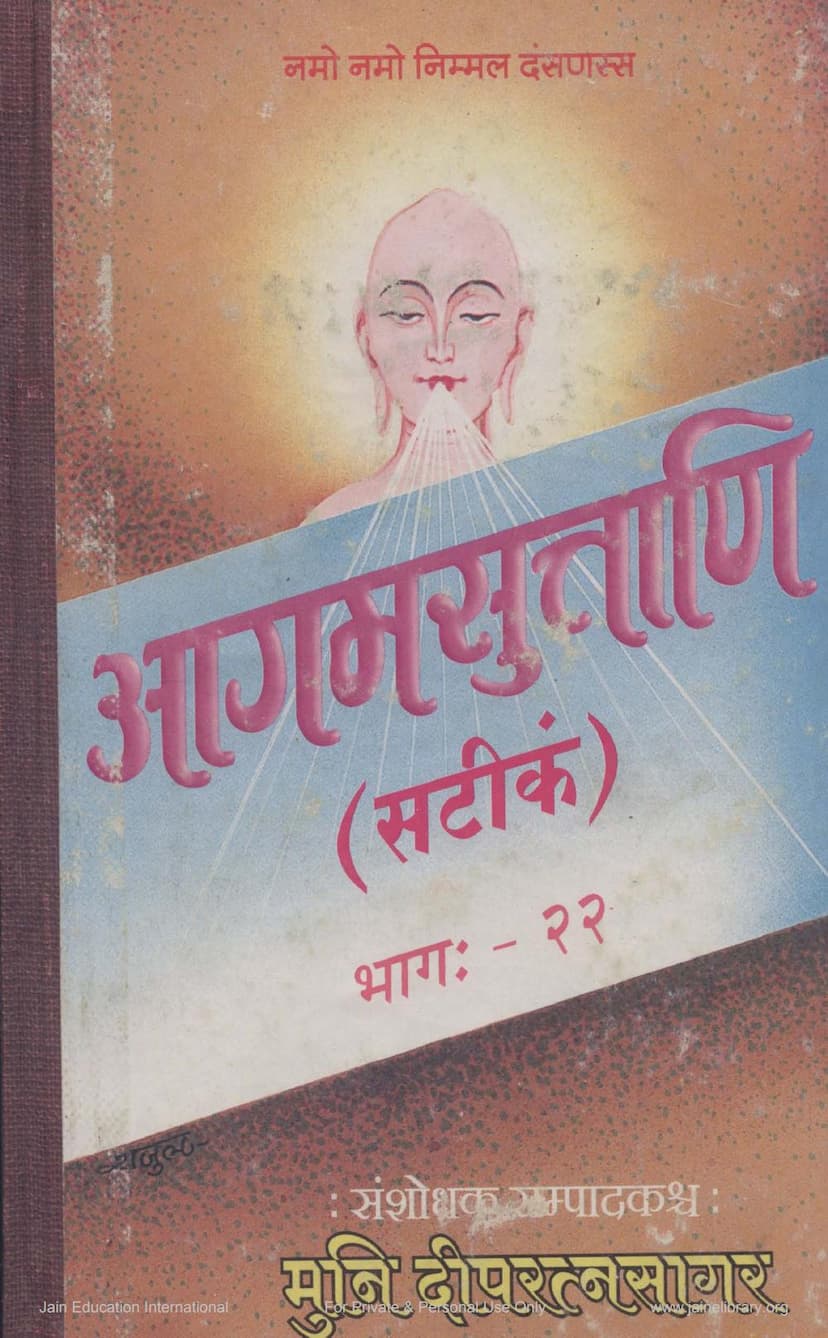Agam Suttani Satikam Part 22 Vyavahara
Added to library: September 1, 2025

Summary
Here's a comprehensive summary of the provided Jain text, "Agam Suttani Satikam Part 22 Vyavahara," based on the provided pages:
Book Title: Agam Suttani Satikam Part 22 Vyavahara Author(s): Dipratnasagar, Deepratnasagar Publisher: Agam Shrut Prakashan Catalog link: https://jainqq.org/explore/003326/1
Overall Context:
This text is part of a larger series called "Agam Suttani Satikam," which aims to provide commentary (with the word "Satikam" often indicating a commentary) on the Jain Agamas (scriptures). Part 22 specifically focuses on the Vyavahara Sutra, which is a fundamental text in Jainism dealing with the rules of conduct, discipline, and daily life for monks and nuns. This particular volume is identified as Vyavahara Chedasutra - 2, indicating it covers the latter part of the Vyavahara Sutra, building upon previous sections.
Key Themes and Content Summary (Based on the provided pages):
The provided pages offer a detailed look into the structure and content of this specific volume of the Vyavahara Sutra commentary.
-
Title and Authorship: The title clearly states it's "Agam Suttani Satikam, Part 22, Vyavahara." The authors are identified as Muni Deepratnasagar (and variations thereof). The publisher is Agam Shrut Prakashan. The inclusion of "JAIN EDUCATION INTERNATIONAL FOR PRIVATE AND PERSONAL USE ONLY" suggests its purpose is educational and for restricted distribution.
-
Structure and Content Outline (Page 3): Page 3 provides a detailed "Vishayanukram" (Table of Contents/Subject Index) for the Vyavahara Chedasutra, specifically noting that Part 21 covered up to Uddeshakas 1-3, and Part 22 covers Uddeshakas 4-10. This indicates a chapter-by-chapter breakdown of the original sutra and its commentary. The index lists specific topics covered within these uddeshakas, including:
- Uddeshaka 4: Rules for monks' (Bhiksus) conduct during different seasons (Hemanta-Gimhasu charie), limits on movement, observance of Chaturmas (Vashavas maryada), communal living (Sanghasya sahavasanam), leadership roles (Ganadhipati padam), solitary wandering (Ekanta vicharanam), rules for nuns (Nirgranthyas), their movement and leadership (pravartini padam), rules for their projects (Achara prakalpa maryada), and mutual service (Vaiyavrtyam).
- Uddeshaka 5: Treatment of injuries (e.g., snakebite), victory over temptations (Mohavijaya), descriptions of miracles (Atishaya varnanam), levels of scriptural knowledge (Alpa shruta - Bahu shruta), atonement (Prayashchitra sutra), and the vow of celibacy (Brahmacharya vrata).
- Uddeshaka 6: Relationships within the monastic community (Gana sambandha), initiation (Diksha), wandering (Vihar), study (Swadhyaya), and teaching (Vachana).
- Uddeshaka 7: Rules concerning nuns (Nirgranthyas), their movement, leadership, projects, and service.
- Uddeshaka 8: Rules for residences (Vasati nivasan), state transitions (Rajya paravartanam), treatment of the deceased (Mrutaka vyavastha), monastery living (Vasati vasah), beds (Shayya - Samstaraka), equipment (Sthiranami upakaranam), receiving donations (Upakarana pradanam), rules for excess utensils (Adhika patrasya vidhih), dietary regulations (Ahar pramanam), and specific rules for mendicants (Bhiskshu pratima, Moksha pratima, Abhigrahasya traividhyam).
- Uddeshaka 9 & 10: Further details on mendicant practices, examination of monks (Shraman pariksha), and discussions related to teachers and disciples (Acharya sambandhi kathan, Shishya sambandhi kathan).
-
Commentary Style (Pages 6-19): The pages from 6 onwards show the actual commentary. The text includes:
- Moola (Root Sutra): The original Jain sutra in Prakrit/Sanskrit.
- Bhāṣya (Commentary): Attributed to Sanghadāsagaṇi (Sanghadāsa Gani), providing a detailed explanation of the sutra.
- Ṭīkā (Elaboration): Attributed to Acārya Malayagiri (Malayagiri Acārya), offering a further, often more philosophical or intricate, explanation of the Bhashya and the original sutra.
-
Specific Topics Highlighted (from the commentary excerpts):
- Rules for Monks' and Nuns' Conduct: The text delves into specific rules regarding seasonal restrictions on movement for monks and nuns, the establishment of monastic residences (Vashavas), the concept of communal living, and the roles of leaders like Acharyas and Upadhyayas.
- Disciplinary Actions and Expiation (Prayashchitta): Several pages discuss various disciplinary actions and expiations based on the severity of transgressions, including specific penalties for violating rules, particularly concerning congregational size (Gachha).
- Ethical and Practical Guidelines: The text covers a wide range of practical matters, such as the proper handling of equipment, dietary rules (Ahar pramanam), conduct during different times and seasons, the importance of adherence to rules, and the consequences of deviation.
- Hierarchical and Relational Rules: It outlines rules governing interactions between different levels of monastic authority (Acharya, Upadhyaya, Ganavachhedaka), and also between monks and nuns.
- Detailed Scenarios and Exceptions: The commentary seems to provide detailed explanations of various scenarios, including exceptions to rules, conditions under which certain actions are permissible or prohibited, and the rationale behind these regulations. For instance, rules regarding the number of monks allowed to travel together or reside together in different seasons are discussed.
- Focus on Vaisya and Vyavahara: The title "Vyavahara" itself points to the practical, everyday rules of conduct. The commentary appears to meticulously detail these for maintaining the purity and discipline of the monastic order.
-
Sponsorship (Page 4-5): Pages 4 and 5 list "Kirthik Anudata" and "Aarthik Anudata" (Sponsors). This indicates that the publication of this detailed commentary was supported by various individuals and Jain sanghas (communities), often in honor of spiritual figures or events. This highlights the importance placed on preserving and disseminating these scriptural texts within the Jain community.
Overall Significance:
This volume of the Agam Suttani Satikam series, focusing on the Vyavahara Sutra, serves as a crucial resource for understanding the practical and ethical framework of Jain monasticism. The detailed commentary by Muni Deepratnasagar and the elaboration by Acharya Malayagiri likely offer deep insights into the nuances of these ancient rules, making them accessible to a Jain audience interested in spiritual and disciplinary practices. The text emphasizes the systematic approach to monastic life, covering a vast array of situations and exceptions.